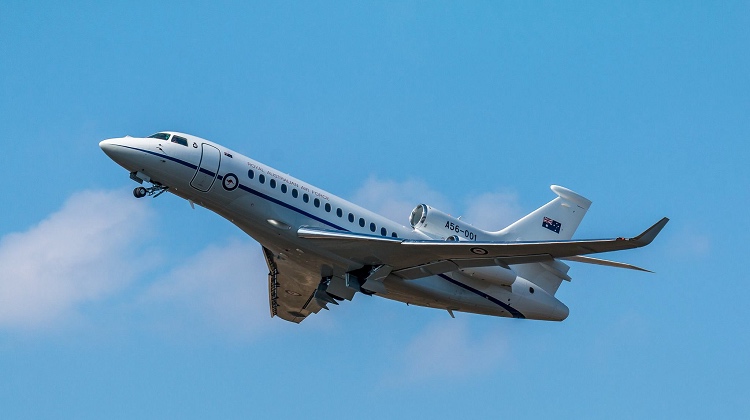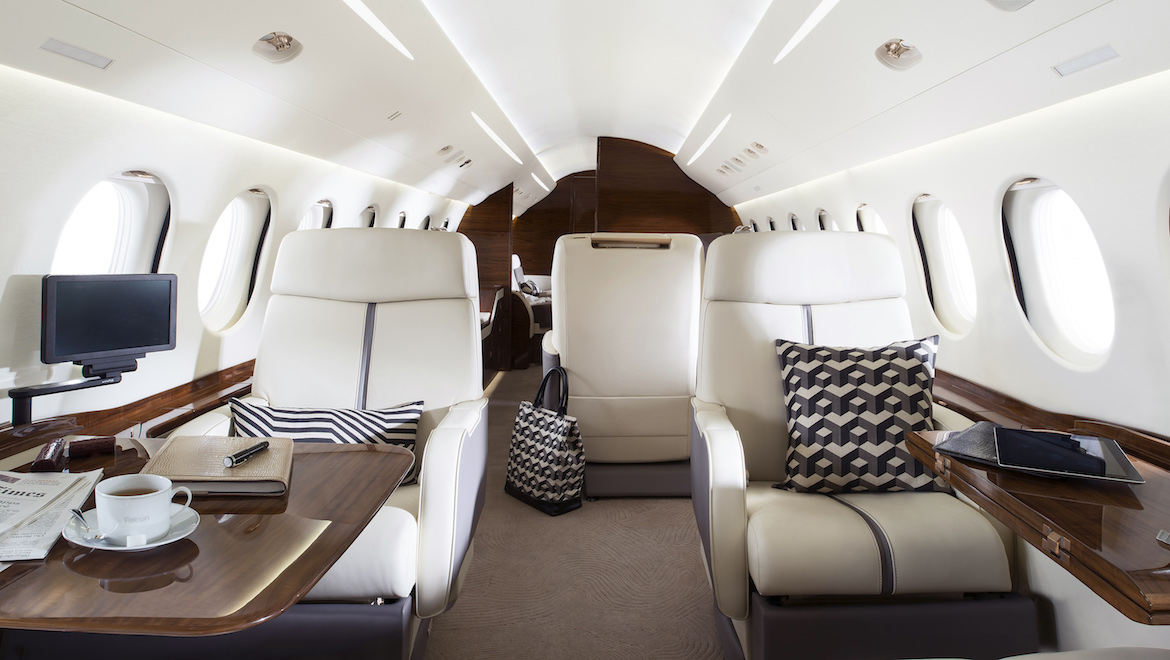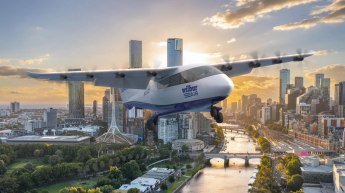
Defence has confirmed that the Royal Australian Air Force (RAAF) has leased three Dassault Falcon 7X business jets to replace the Bombardier Challenger CL-604 jets operated by 34SQN in Canberra as VIP special purpose aircraft (SPA).
The first of the three aircraft was ferried from Dassault’s Merignac facility near Bordeaux, France, to a cabin interior finishing centre in Little Rock, Arkansas on March 29 using the “ASY” callsign commonly used by RAAF air mobility group (AMG) aircraft.
The aircraft was painted in familiar RAAF VIP fleet colours.
The Falcon 7X is a major capability leap from the smaller CL-604. It is powered by three P&W PW307A engines, has a maximum operating speed of 0.90 Mach and a range of up to 5,950nm, giving it a one-stop range capability to almost any destination on earth.
Just as importantly, the Falcon 7X has good short-field performance and a low pavement rating, allowing it to operate into remote and regional airfields.
The 12-16 seat cabin is 11.9m long and offers stand-up headroom of 1.88m, although it is not known what the RAAF cabin configuration will be. When cruising at 45,000 feet, the Falcon 7X has a relative cabin pressure of 4,000 feet.
Since 2001, Northrop Grumman Integrated Defence Services IDS (previously Qantas Defence Services) has delivered through-life support to 34 Squadron at Defence Establishment Fairbairn, which operates the current SPA fleet of two Boeing Business Jets (BBJs) and three Bombardier Challenger 604s.
All five aircraft, which are leased rather than Commonwealth-owned, entered service in 2002. They are still relatively young aircraft in terms of flying hours, with the fleet recently passing the 50,000 flying hour milestone.



The acquisition of the three Falcon 7X aircraft dates back to November 2015, when Defence released a Request for Proposal (RFP) seeking a managing contractor to provide services for the maintenance, support and replacement of the Special Purpose Aircraft (SPA) fleet.
The purpose of the RFP, which closed in February 2016, was to identify and assess the feasibility, risk, affordability, value and overall suitability of the range of available capability options and managing contractor methodologies.
Defence undertook an evaluation, and two companies were shortlisted from the RFP respondents in June 2016.
In August 2016, Defence initiated a project definition study to engage with the shortlisted respondents to collaboratively finalise contract requirements and develop a Request for Tender (RFT).
The RFT was released to the two shortlisted companies in December 2016, and in February 2017 the industry respondents tabled their tenders to Defence.
Meanwhile, Defence in 2017 exercised options that extended the SPA maintenance and support arrangement with Northrop Grumman IDS until September 2019 to align with the lease terms of the current fleet.
Separate to the SPA process, the RAAF’s VIP capabilities will also be boosted with the delivery of a KC-30A Multi Role Tanker Transport modified to support long-range government VIP transport needs due for delivery in late 2019.
VIDEO: A look at the Dassault Falcon 7X from the manufacturer’s YouTube channel.
















Greg
says:What was once old (and too expensive) is new again ..
I remember when the Australian government had Falcon “tri-holders” in the past ..
They were replaced with the challengers because they were too expensive to run
Peter Bourke
says:Are the 34 SQN 737s being replaced by the KC-30s?
Corey
says:Who was the other company bidding for the contract and I’m surprised they went with Tri jets. Would have thought the G550/650 would have been a very close contender or Global 7000.
Tom
says:ExecuJet
Bob
says:Well a 7x is a slightly newer beast than a 9000. Plus being leased means the costs are known and cheaper than if they were bought. Plus you can upgrade the aircraft at the end of the lease if you want , which is a lot easier than disposing off, and then acquiring a new platform
Gary
says:Peter – only the Challengers are being replaced. 34SQN will have a three tiered fleet of Falcon, BBJ and KC30.
Ben
says:Tri-jet? Strange when twins are the norm everywhere else. With the ELINT G550 coming you’d think type commonality would make a Gulfstream product a no-brainer.
Peter
says:Tri-jet = safer
Tom
says:Load of rubbish. How come A330/A350/B787/B777/A220/A320/B737 and all other business jets have only two engines? 3 engines is useful for EROPS/ETOPS but the main reason they chose the 7X is cheaper to lease and operate and wider range of runways it can operate into. Whether that was the correct decision or not is of course debatable, but there was certainly no question of safety.
TwinTiger
says:Not one to create a conspiracy theory, however perhaps there is a touch of a French-Australian Government connection as a side deal with the Submarines….
I agree with @Ben, that a Gulfstream 550 would have been equally appropriate, with similar characteristics to the Falcon 7X, and provided some commonality in maintenance and pilot training with the new Peregrines.